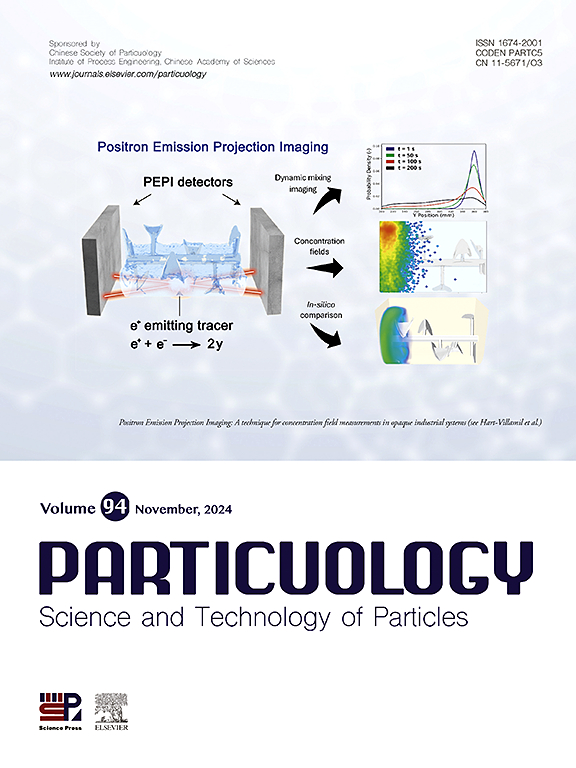基于超椭球模型的非球形颗粒流固耦合求解LBM-DEM方法
IF 4.3
2区 材料科学
Q2 ENGINEERING, CHEMICAL
引用次数: 0
摘要
本文介绍了一种基于晶格玻尔兹曼法和离散元法的求解耦合方法,用于模拟涉及非球形粒子的流体-颗粒相互作用。采用超椭球模型,可以高精度、高效率地表示大范围的颗粒形状,从而可以详细研究形状对流动行为的影响。通过对球形和非球形颗粒沉降的模拟结果与实验数据的比较,验证了该方法的有效性。在此基础上,研究了含不同非球形颗粒的流化床系统,并研究了颗粒形状对流场的影响。结果进一步证实了该方法在复杂多相流系统中的准确性和鲁棒性。与现有的LBM-DEM耦合方法相比,该方法对光滑表面颗粒流场的模拟更加精确和高效,为研究规则非球形颗粒多相系统提供了有力的工具。本文章由计算机程序翻译,如有差异,请以英文原文为准。

A resolved LBM-DEM coupling method for fluid-solid interaction of non-spherical particles based on the super-ellipsoid model
This paper introduces a resolved coupling method based on the LBM (Lattice Boltzmann Method and DEM (Discrete Element Method) for simulating fluid-particle interactions involving non-spherical particles. The super-ellipsoid model is applied so that a wide range of particle shapes can be represented with high accuracy and efficiency, enabling a detailed investigation of shape effects on flow behavior. The proposed method is validated by comparing simulation results with experimental data on the sedimentation of both spherical and non-spherical particles. Then a fluidized bed system containing different kinds of non-spherical particles is studied and the influence of particle shape on the flow field is investigated. The result further confirms the accuracy and robustness of this method in complex multiphase flow systems. Compared to existing LBM-DEM coupling approaches, this study is more accurate and efficient for simulating flow fields involving particles with smooth surfaces, offering a powerful tool for the study of multiphase systems with regular non-spherical particles.
求助全文
通过发布文献求助,成功后即可免费获取论文全文。
去求助
来源期刊

Particuology
工程技术-材料科学:综合
CiteScore
6.70
自引率
2.90%
发文量
1730
审稿时长
32 days
期刊介绍:
The word ‘particuology’ was coined to parallel the discipline for the science and technology of particles.
Particuology is an interdisciplinary journal that publishes frontier research articles and critical reviews on the discovery, formulation and engineering of particulate materials, processes and systems. It especially welcomes contributions utilising advanced theoretical, modelling and measurement methods to enable the discovery and creation of new particulate materials, and the manufacturing of functional particulate-based products, such as sensors.
Papers are handled by Thematic Editors who oversee contributions from specific subject fields. These fields are classified into: Particle Synthesis and Modification; Particle Characterization and Measurement; Granular Systems and Bulk Solids Technology; Fluidization and Particle-Fluid Systems; Aerosols; and Applications of Particle Technology.
Key topics concerning the creation and processing of particulates include:
-Modelling and simulation of particle formation, collective behaviour of particles and systems for particle production over a broad spectrum of length scales
-Mining of experimental data for particle synthesis and surface properties to facilitate the creation of new materials and processes
-Particle design and preparation including controlled response and sensing functionalities in formation, delivery systems and biological systems, etc.
-Experimental and computational methods for visualization and analysis of particulate system.
These topics are broadly relevant to the production of materials, pharmaceuticals and food, and to the conversion of energy resources to fuels and protection of the environment.
 求助内容:
求助内容: 应助结果提醒方式:
应助结果提醒方式:


